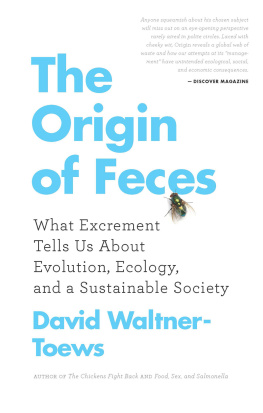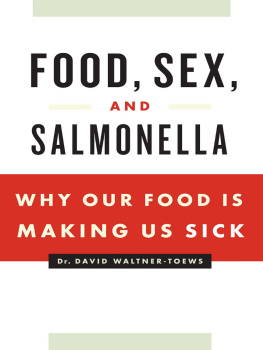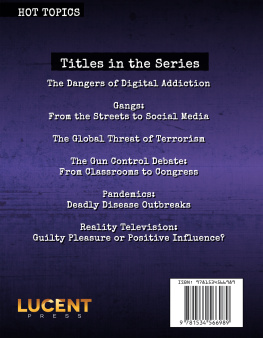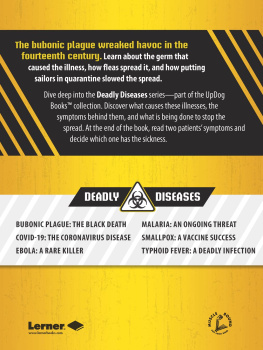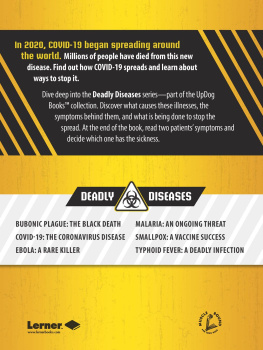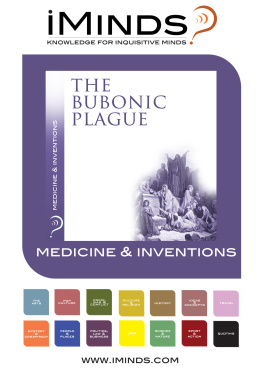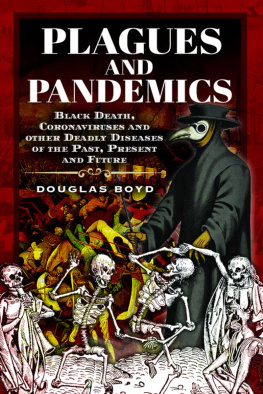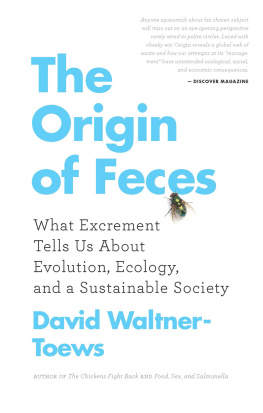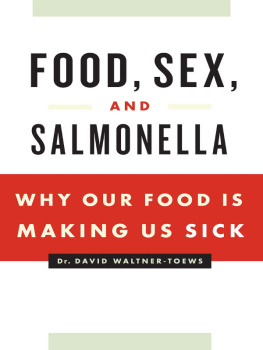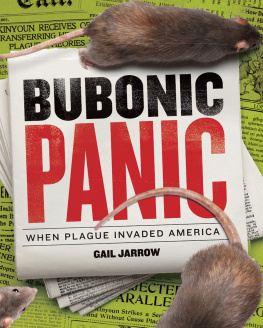David Waltner-Toews - On Pandemics: Deadly Diseases from Bubonic Plague to Coronavirus
Here you can read online David Waltner-Toews - On Pandemics: Deadly Diseases from Bubonic Plague to Coronavirus full text of the book (entire story) in english for free. Download pdf and epub, get meaning, cover and reviews about this ebook. year: 2020, publisher: Greystone Books, genre: Romance novel. Description of the work, (preface) as well as reviews are available. Best literature library LitArk.com created for fans of good reading and offers a wide selection of genres:
Romance novel
Science fiction
Adventure
Detective
Science
History
Home and family
Prose
Art
Politics
Computer
Non-fiction
Religion
Business
Children
Humor
Choose a favorite category and find really read worthwhile books. Enjoy immersion in the world of imagination, feel the emotions of the characters or learn something new for yourself, make an fascinating discovery.

- Book:On Pandemics: Deadly Diseases from Bubonic Plague to Coronavirus
- Author:
- Publisher:Greystone Books
- Genre:
- Year:2020
- Rating:4 / 5
- Favourites:Add to favourites
- Your mark:
- 80
- 1
- 2
- 3
- 4
- 5
On Pandemics: Deadly Diseases from Bubonic Plague to Coronavirus: summary, description and annotation
We offer to read an annotation, description, summary or preface (depends on what the author of the book "On Pandemics: Deadly Diseases from Bubonic Plague to Coronavirus" wrote himself). If you haven't found the necessary information about the book — write in the comments, we will try to find it.
On Pandemics: Deadly Diseases from Bubonic Plague to Coronavirus — read online for free the complete book (whole text) full work
Below is the text of the book, divided by pages. System saving the place of the last page read, allows you to conveniently read the book "On Pandemics: Deadly Diseases from Bubonic Plague to Coronavirus" online for free, without having to search again every time where you left off. Put a bookmark, and you can go to the page where you finished reading at any time.
Font size:
Interval:
Bookmark:


Copyright 2020 by David Waltner-Toews
Originally published as The Chickens Fight Back: Pandemic Panics and Deadly Diseases That Jump from Animals to Humans by David Waltner-Toews 2007 Greystone Books
20 21 22 23 24 5 4 3 2 1
The quote on page 45 from The Plague, by Albert Camus, is from a translation by Stuart Gilbert, published by The Modern Library, Random House, 1948.
All rights reserved. No part of this book may be reproduced, stored in a retrieval system or transmitted, in any form or by any means, without the prior written consent of the publisher or a license from The Canadian Copyright Licensing Agency (Access Copyright). For a copyright license, visit accesscopyright.ca or call toll free to 1-800-893-5777.
Greystone Books Ltd.
greystonebooks.com
Cataloguing data available from Library and Archives Canada
ISBN 978-1-77164-811-0 (pbk.)
ISBN 978-1-77164-812-7 (epub)
Editing by Nancy Flight
Copy editing by Wendy Fitzgibbons
Editing for second edition by Paula Ayer
Proofreading by Alison Strobel
Cover design by Nayeli Jimenez
Text design by Nayeli Jimenez and Naomi MacDougall
Cover photograph by Bernhard Lang/Getty Images
Greystone Books gratefully acknowledges the Musqueam, Squamish, and Tsleil-Waututh peoples on whose land our office is located.
Greystone Books thanks the Canada Council for the Arts, the British Columbia Arts Council, the Province of British Columbia through the Book Publishing Tax Credit, and the Government of Canada for supporting our publishing activities.

For two great teachers of veterinary epidemiologythe late John Iversen, who inspired me to care about the dead skunk in the middle of the road, and Wayne Martin, who taught me to measure its significance
From ghoulies and ghosties
And long-leggedy beasties
And things that go bump in the night,
Good Lord, deliver us!
A traditional prayer, of unknown provenance
CONTENTS
( 1 )
AN INTRODUCTION TO THE SECOND EDITION
I WROTE THE first edition of this book in the turbulent wake of avian influenzas spectacular appearance in the late 1990s, and the even more dramatic SARS alarm early in this century. In quite different ways, both diseases awakened fears and memories of the 1918 influenza pandemic, and led to widespread animal slaughtering, airport closings, government panic, mayoral rants, and rock concerts. On the other hand, the pandemic of influenza that swept around the world in 2009 and 2010, first called swine flu, and later given the technical moniker H1N1, evoked measured responses accompanied by widespread skepticism.
In 2020, I am writing this second edition of the book during a global lockdown in response to the explosive spread of SARS-COV-2 (the virus) and COVID-19 (the disease it causes). COVID-19 has now joined the list of pandemics, near-pandemics, and possible pandemics that have long haunted human history. With popular names such as SARS, bird flu, swine flu, Ebola, and bubonic plague, these diseases all have one thing in common: they are zoonoses, diseases that have made the jump from their natural homes in other animals to take up residence in people. Some of themthe influenzas, mostlytook the direct route from chickens or pigs to people. Others, such as Ebola, COVID-19, and SARS, took a more circuitous route from bats, pausing at rest stops in one or two other animalscivets, monkeys, or pangolins, perhapsbefore they found their way to humans. Welcome to the twenty-first century.
The eruption and worldwide spread of SARS-COV-2 was, some might assert, predictable, but predictable only in the sense that earthquakes and volcanic eruptions in certain parts of the world are predictable. The Ring of Fire, for instance, home to more than three-quarters of the worlds volcanoes, is a horseshoe-shaped area rimming the Pacific Ocean. We can predict that there will be volcanic eruptions and earthquakes along this rim, but exactly where and when they will occur is uncertain.
There were reports, of course, briefings, warnings about emerging infectious diseases, rumors of chimeric viruses that bore traces of their animal origins. In retrospect the reports should have been heeded; they werent just angry jeremiads. They were based on scientific studies and simulations. But there were events other than rogue viruses in a Chinese market that kept us distracted. And in our collective distraction and denial, we were surprised. I could say we shouldnt have been surprised, but Ive never found retrospective told-you-sos to be comforting or useful.
Even the most scientifically literate among us might be forgiven our skepticism that an outbreak led by an unstable, albeit crowned, virus, was going to usher in a New Age, or even a Different Age. Some might argue, based on good evidence, that crowned heads have always been somewhat unstable. On the other hand, we wouldnt be the first to have underestimated the impact of a small eventsay, a butterfly flapping its wings in Brazil on storms in Texas. The world is more chaotic, less predictable, than we would like to believe.
Many of the pandemics imagined in movies and novels before 2020 involved apocalyptic scenarios that included people stumbling through garbage-strewn streets, bleeding from all orifices, zombies, billions dead, and bodies in the street. Perhaps a few religious or ideologically obsessed zealots even wished, mostly in secret, for one of those God-save-us pandemics that historian Walter Scheidel announced might provide a sufficiently violent shock to upend the established order and flatten disparities in income and wealth.
What most literary scenarios did not imagine was an infection that spread rapidly, infected hundreds of thousands, and seemed to kill almost at random. Of course, as with previous pandemics, COVID-19 has tended to kill more older people, and people whose immune systems were already under duress from cancer or diabetes or heart disease. But what has struck many observers, myself included, was how two healthy people in the prime of life could be infected with SARS-COV-2, and one of them, without any reasonable medical explanation, would die, while the other lived. This almost seemed like the random drive-by shootings described by my Colombian colleagues from the 1990s.
So, yes, the SARS-COV-2 pandemic was predictable, but as one of my Italian colleagues, in lockdown as I write this, said, Even in the case of an earthquake, whilst the earth is shaking, the first reaction (seconds or less) is denial: it is impossible, it cannot be true, not here! And even afterward, when you see the ruins, its still hard to believe.
Most of us have been made aware of the ravaged landscapes, lost habitats, and disappearing megafauna that have characterized the past century. We fret about the extinctions of birds and rhinos. We try to save some arthropods, like bees and butterflies, even as we try to kill others, like mosquitoes. Still, even the most conservation-minded among us rarely think about the trillions of viruses, yeasts, fungi, and bacteria for whom these disappearing animals are home, or about where those microfauna might look for new homes once we raze their habitats for mines, cattle ranches, or cities. The diseases described in this book are, in a sense, about microscopic refugees from those lost habitats and disappearing species.
Font size:
Interval:
Bookmark:
Similar books «On Pandemics: Deadly Diseases from Bubonic Plague to Coronavirus»
Look at similar books to On Pandemics: Deadly Diseases from Bubonic Plague to Coronavirus. We have selected literature similar in name and meaning in the hope of providing readers with more options to find new, interesting, not yet read works.
Discussion, reviews of the book On Pandemics: Deadly Diseases from Bubonic Plague to Coronavirus and just readers' own opinions. Leave your comments, write what you think about the work, its meaning or the main characters. Specify what exactly you liked and what you didn't like, and why you think so.

